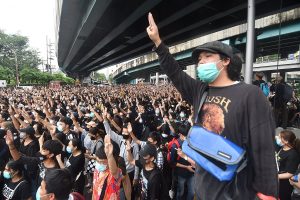Diplomat author Mercy Kuo regularly engages subject-matter experts, policy practitioners, and strategic thinkers across the globe for their diverse insights into Asia affairs. This conversation with Dr. Tamara Loos – chair and professor at the Department of History at Cornell University – outlines why the current protests in Thailand are different from any the country has seen before.
Briefly explain the context of current domestic protests in Thailand.
Demonstrators in Thailand today clamor for three main changes: the resignation of Prime Minister Prayut Chan-o-cha, revision of the constitution to allow for greater democratic participation, and reform of the monarchy to subject it to legal, political, and fiscal oversight. These peaceful protests differ radically from unrest in the past for several reasons.
First, Thai citizens openly challenge the role of the monarchy in Thai cultural and political life, which reveals a revolutionary cultural shift. Self-censorship and lese majesté laws that once prevented Thais from publicly expressing their concerns about the role of the monarchy in politics no longer apply. The institution of the monarchy is now subject to public debate and discussion.
Second, middle school, high school, and college-age Thais make up the majority of protesters, rather than older generations who filled the streets in the color-coded protests in the early 2000s. These youth demand holistic changes to Thailand’s education system, strict gender conformity, constitution, and monarchy.
Third, social media plays a pronounced role in the demonstrations because these internet platforms are not subject to the same degree of control by the Thai army or government broadcasting authorities, unlike TV and radio. Protesters deftly utilize social media to connect with each other and supporters around the world and enable them to mobilize quickly.
Analyze the tipping point of demonstrations and implications for domestic reform.
When human rights lawyer Anon Nampa publicly broached the topic of the monarchy at a rally in August 2020, he unleashed a flood of pent up criticism. A necessary precondition for this tipping point was the ascension of King Vajiralongkorn, a monarch who fails to live up to the dignified image and ethical standards of his father, King Bhumibol. Whereas King Bhumibol promoted frugality, personal reserve, and traditional heteronormative monogamy, his son has been married four times and resurrected the long-dead institution of polygyny. In addition, the new king’s opulent lifestyle, residence abroad, and apparent disinterest in the financial hardship of Thais impacted by economic consequences of COVID-19 diverge significantly from the image of his father’s public morality and concern for the lives of his subjects.
Identify the key stakeholders in shaping the dialogue between the Thai government and demonstrators.
The army, the monarchy and its supporters, and the diverse assemblage that makes up the progressive movement are the three main stakeholders in this conflict, which so far have not engaged in substantive dialogue.
The Royal Palace has remained remarkably silent despite demonstrations that demand a response from the king. For example, protesters set up mailboxes in front of the Grand Palace in which they placed letters to the king demanding monarchical reform. Police “accidentally” fired water cannons at the peaceful demonstrators. By contrast, pro-royalist supporters have become increasingly militant in their response to calls for monarchical reform.
The army considers itself first and foremost the protector of the monarchy, which in turn lends legitimacy to the army by endorsing coups. By openly questioning the legitimacy of the monarchy, protesters also challenge that of the army and its political interventions.
The loose coalition of groups that comprise the protesters symbolically represent Thailand’s future. Their protests are peaceful and inclusive and their demands are for reform, not abolition, of the monarchy. For these reasons, the cost of committing violence against them is high and could lead to de-legitimation of the monarchy and military.
Describe three scenarios – good, bad and ugly – of plausible outcomes of negotiations.
As a thought experiment, one can imagine three possible scenarios. In one, King Vajiralongkorn intervenes on the side of the protest and agrees to reform the monarchy. He did, after all, declare that “we love them all the same.” This would decrease his wealth and political power, but potentially increase the cultural capital of the monarchy as an institution. The next step would entail a revision in the relationship between the military and the monarchy to enable a strengthening of democratic institutions.
In another, the military stages a coup against Prayut, the former army commander-in-chief who staged the last coup. Factionalism within the army may stabilize behind the king, all of which suggests increased repression. While a coup will satisfy one demand made by protesters for the resignation of the prime minister, it will not satisfy their demands for greater participatory democracy or reform of the monarchy. It would instead widen the chasm between the new generation of protesters and the established authority of the military and monarchy. If a coup leads to a violent crackdown, it is possible their efforts will backfire and increase support for the protesters, who are the sons and daughters of Thailand’s middle classes.
A third scenario might see a continuation of protests and arrest of its leaders until the movement is drained of momentum. However, they have permanently transformed public culture regarding the monarchy, which will be subject to continued critique. This only delays a future conflict between those who want genuine change in Thailand’s political institutions and the military.
Assess the impact of Thai protests on U.S.-China geopolitical rivalry in the region.
The U.S. government has played almost no role in these events, despite conspiracy theories that allege CIA backing of demonstrators — an ironic claim given the United States’ buttressing of the Thai monarchy as a bulwark against communist influence during the Cold War era. Historically, the U.S. has preferred an economically liberal, stable regime, even if it is a military-backed monarchy, over a genuinely democratic but potentially unstable government in Thailand.

































